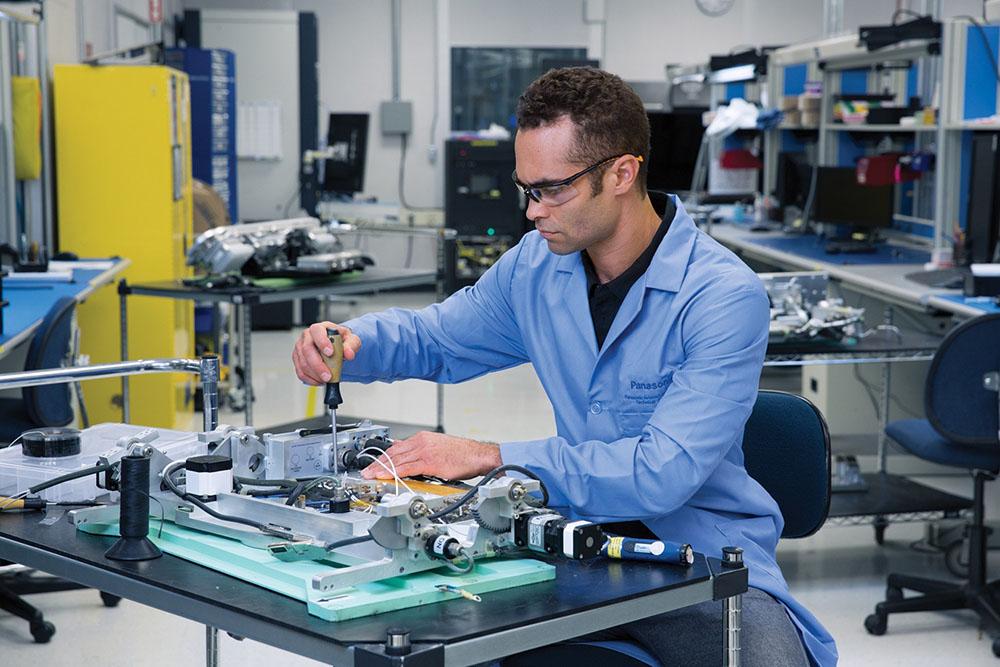
ATLANTA—Growing demand for inflight connectivity and the introduction of new aftermarket services is driving a hiring push at Panasonic Avionics. At Aviation Week’s recent MRO Americas event in Atlanta, Panasonic Technical Services Vice President and General Manager Tom Eskola told Aviation Week the company plans to hire more than 200 new staff across its network.
To feed the workforce pipeline, Panasonic is relying on a four-pronged strategy that includes connecting with students at local colleges and training centers, offering a comprehensive training program for new junior mechanics, ramping up international hiring and a new apprenticeship program it recently launched in the UK.
“In some locations, the competition is so tight with airlines that there are no qualified candidates that we’re able to bring on, so we have to bring them from other places,” notes Eskola. “We’ve begun to sponsor visas in different locations to bring people in from one country or another to fill gaps we might have in certain locations.”
While the process can be challenging due to different, complex rules in various countries, Eskola says Panasonic’s global presence has been a benefit. “We’ve been very lucky because Panasonic is a global company and, in certain locations, we’re able to rely on our corporate support and legal support that we already have in the region. We’re able to operate in a way that allows us to do the sponsorship ourselves,” he says.
Part of what is driving hiring is Panasonic’s recent growth into ground handling and cabin maintenance. “We now have seven locations where we’re offering ground handling, and it’s a little bit different from the Panasonic typical inflight entertainment (IFE) line maintenance activities that we do,” says Eskola. “We have trained and certified qualified mechanics that are able to sign off on work for the airplane itself.”
Eskola says Panasonic’s global footprint also has been helpful in standing up these new maintenance capabilities. “I think it was a perfect storm in a lot of ways, because from a demand perspective, right now we are competing for staff with other airlines and MROs around the world. And, at the same time we’re competing, airlines recognize that they would rather contract out some of that work than do it themselves,” he says. “In those situations, we’ve been able to expand our services where an airline wasn’t willing or didn’t want to continue that service.”
Despite growth in new service offerings, Eskola notes that Panasonic is still concentrating on innovation within the avionics space. “What we’re seeing is airlines are more focused than ever on making sure that when an aircraft takes off, every seat is operating properly, every seatback monitor works, every functionality that’s within the user interface is operating properly and the Wi-Fi systems are also operating to their peak capability. The load factors are higher than I’ve ever seen them in my 16 years of working in this industry,” he says.
Panasonic plans to launch a next-generation IFE system called Astrova next year, which Eskola says will be a step change in seatback monitor capability. “Today you have a lot of complicated systems that are all operating together, and you have these AC outlets where everybody’s bringing their big power block onboard the aircraft and trying to connect and charge their devices,” he says. The Astrova system will include a power bar and USB-C port with up to 67 watts of power, enabling charging of tablets, mobile phones and laptops.
Eskola says the system will also provide benefits for passengers who want to pair their headphones with seatback IFE. “The systems are getting lighter, they’re getting more efficient and they are also bringing a lot more capability to the seatback to include Bluetooth audio,” he says. “Every passenger, if they have their own Bluetooth headphones, will be able to use them directly with the monitor instead of having to purchase a set that’s not as good.”
Digitalization at Panasonic is also happening outside the cabin. Eskola says Panasonic Technical Services has been waging a ‘war on paper’ by implementing digital technology from Ramco Systems in its repair centers and throughout its network. “We’ve recently made a big investment with Ramco to be able to have iPads in the hands of every technician. We’re rolling out an upgrade to have them connected to the internet, so every time a technician gets on an airplane, they’ll have that Ramco iPad that gives them visibility into so many different aspects of our business and prevents them from having to print out papers or carry manuals,” he says.
Panasonic is also working to electrify its global fleet of more than 200 vehicles. “Every time we have a lease renewal, we look at those options,” says Eskola. “We’re struggling a little bit with airport infrastructure because there are a lot of airports around the world that don’t yet have charging stations to be able to support that. Where we can, we’re working with airport authorities to ensure the infrastructure is present to be able to do that.





